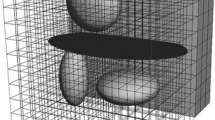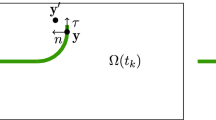Abstract
Numerical algorithm to simulate 2-D smooth crack is presented. The stepwise method based on local criteria of propagation is used. Two crack propagation criteria are employed. At the first stage of propagation, the maximum tensile stress criterion is used to take into account the abrupt change in tangent direction. At subsequent stages, the assumption that the stress intensity factor (SIF) K_2= 0 at the current crack tip is exploited. The analytical formulae for calculating SIFs are given. The displacement discontinuities (DD) involved in these formulae are found from the numerical solution of a complex hypersingular integral equation (CHSIE) for a piecewise homogeneous plane with curvilinear cracks. The new mechanism of smooth approximation of the crack path by circular arcs at each propagation stage is suggested. Numerical results are given. They confirm the efficiency of the algorithm suggested.
Similar content being viewed by others
References
Bueckner, H.F. (1958). The propagation of cracks and the energy of elastic deformation. Transactions of the ASME (ser. D) 80, 111–116.
Berchenko, I. and Detournay, E. (1996). Deviation of hydraulic fractures through poroelastic stress changes induced by fluid injection and pumping. International Journal of Rock Mechanics and Mining Science (submitted).
Cotterell, B. and Rice, J.R. (1980). Slightly curved or kinked cracks. International Journal of Fracture 16, 155–169.
Cotterell, B. (1965). On brittle fracture paths. International Journal of Fracture Mechanics 1, 96–103.
Kitagawa, H. and Yuuki, R. (1977). Analysis of branched cracks under biaxial stresses. In: Fracture 1977. University of Waterloo Press 3, 201.
Kudrjavtzev, B., Morozov, E. and Parton, V. (1968). On the calculation of curvilinear cracks's trajectory. Izvestia Academy Nauk SSSR Mechanica Tverdogo Tela 3, 185–187 (in Russian).
Linkov, A.M. and Mogilevskaya, S.G. (1991). Complex hypersingular integrals and integral equations in plane problems of elasticity theory. In: Researches on Structure Mechanics and Materials. Leningrad. Institute for Building Engineering Leningrad, 17–34 (in Russian).
Linkov, A.M. (1983). Plane problems of the static loading of a piecewise homogeneous linearly elastic medium. Journal of Applied Mathematics and Mechanics 47, 527–532.
Linkov, A.M. and Mogilevskaya, S.G. (1995). On the theory of complex hypersingular equations. In: S.N. Atluri, G. Yagawa and T.A. Cruse (eds.): Computational Mechanics '95. Springer-Verlag, Berlin, Heidelberg, New York, 2, 2836–2840.
Lo, K.K. (1978). Analysis of branched cracks. Journal of Applied Applied Mechanics 45, 797–802.
Mau, S.T. and Yang, M.S. (1977). Some applications of a hybrid finite element method to crack problems. In: Proceedings International Conference of Fracture Mechanics and Technology. Hong Kong. Alphen aan den Rijn 2, 1467–1482.
Miyamoto, H., Fucuda, S., Kujirai, Y. and Sumikawa, K. (1977). Prediction of fatigue crack path by finite element method. Journal of Fracture Engineering University Tokio 34, (Ser B) 339–348.
Mogilevskaya, S.G. (1996a). The universal algorithm based on complex hypersingular equation to solve plane elasticity problems. Computational Mechanics 18, 127–138.
Mogilevskaya, S.G. (1996b). The complex one-sided integrals of Cauchy and Hadamard and application to BEM. (accepted to International Journal for Numerical and Analytical Methods in Geomechanics).
Mogilevskaya, S.G. (1997). Complex hypersingular integral equation for the piecewise homogeneous half-plane with the cracks In: B. Annin, V. Monakhov and V. Teshukov (eds.): Mathematical problems of Mechanics of Solids. Novosibirsk University, Novosibirsk, 100–101 (in Russian).
Murakami, Y. (1987). Stress Intensity Factors Handbook. Pergamon Press Oxford.
Morozov, E.M. (1978). The method of the calculation of crack's static trajectory. Physics and Mechanics of Fracture 5, 67–75 (in Russian).
Parton, V.Z. and Morozov, E.M. (1985). Mechanics of elasto-plastic fracture. Nauka, Moscow (in Russian).
Radon, J.C., Leevers, P.S. and Culver, L.E. (1977). Fracture toughness of PMMA under biaxial stress. In: Fracture 1977. University of Waterloo Press 3, 113–118.
Savruk, M.P. (1981). Two-dimensional problems of elasticity for body with crack. Naukova Dumka, Kiev, (in Russian).
Sih, G.C. (1974). Strain-energy-density factor applied to mixed mode crack problems. International Journal of Fracture 10, 305–321.
Volkov, V.M. (ed.) (1987). Approximation of the compound curves by the arcs of the circles and its application to the problems of mechanical engineering. Kuzbass Technical University. Kemerovo (in Russian).
Wei, R.P. and Landes, J.D. (1969). Correlation between sustained load and fatigue crack growth in high strength steels. Mathematical Res. and Stand. 2, 25–46.
Zang, W.L. (1990). On modeling of piece-wise smooth cracks in two-dimensional finite bodies. International Journal of Fracture 46, 41–55.
Author information
Authors and Affiliations
Rights and permissions
About this article
Cite this article
Mogilevskaya, S. Numerical modeling of 2-D smooth crack growth. International Journal of Fracture 87, 389–405 (1997). https://doi.org/10.1023/A:1007465204062
Issue Date:
DOI: https://doi.org/10.1023/A:1007465204062




